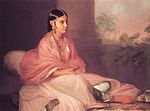Rajshahi silk

Rajshahi silk is the name given to the silk products produced in Rajshahi, Bangladesh. It is famous because it is a high quality fabric used for clothing, especially for saris.[1][2] In 2021, it was given Geographical indication status as a product of Bangladesh.[3]
History[]
Records date the beginning of silk production in the region to the 13th century. It was then known as Bengal silk or Ganges silk.[4] The government of Pakistan started silk production in Rajshahi in 1952.[5] The was a state owned factory which was founded in 1961. In 1978 it was handed over to the Bangladesh Sericulture Development Board. Since then it has been making a loss. It was closed down on 30 November 2002.[6] Before 2002300 tonnes of strings were produced by this factory. In 2011 it was only 50 tonnes.[5] In 2011 the finance minister of Bangladesh, Abul Maal Abdul Muhith,[7] expressed interest in reopening the Rajshahi silk factory but the Privatisation Commission refused on the grounds that it was a loss making concern.[8]
Types[]

Rajshahi silk is like all other kinds of silk made from the cocoons of silkworms. The very thin fibers resulting from this process are covered with sericin, a special protein.[9] There are mainly three varieties of silks:
- Mulberry silk
- Eri silk (Endi silk) and
- Tassar silk.
Among these varieties, Mulberry silk is the finest and is therefore the most valuable.
Clothes like Saris made out of Rajshahi silk are highly popular all over Bangladesh.[9] Rajshahi silk is also sold as fabric to designers and is available in different colours and designs.
Significance[]
In 2011 there were seven silk factories and the Bangladesh Sericulture Research and Training Institute in Rajshahi. Most of the silk of Bangladesh is produced by the region's sericulture.[5] Approximately 100,000 people are directly or indirectly employed in this sector. Rajshahi Silk Industry and Factory Labourers' Union represent the workers in the silk industry.[10]
Gallery[]
| Wikimedia Commons has media related to Rajshahi silk. |

Silk cocoon

Silk cocoon

Silk cocoon

Silk cocoon

Silk weaving

Waxing on Rajshahi silk

References[]
- ^ "Silk pyjamas, artworks, dinner set, leather bag set – Gifts from Bangladesh to India". deccanchronicle.com/. 2017-04-08. Retrieved 2017-04-20.
- ^ "Rajshahi's brand name 'Silky Rajshahi'". The Financial Express. Dhaka. Retrieved 2017-04-20.
- ^ "রাজশাহী সিল্ক এখন জিআই পণ্য". Samakal (in Bengali). Retrieved 2 April 2021.
- ^ "Silk of Bengal". The Daily Star. 2016-02-23. Retrieved 2017-04-23.
- ^ a b c "Rajshahi Silk Losing Shine". The Daily Star. 2011-06-13. Retrieved 2017-04-23.
- ^ "Rajshahi Silk Factory to reopen this year". The Daily Star. 2011-06-20. Retrieved 2017-04-23.
- ^ "Muhith backs plan to revive Rajshahi Silk Factory". The Daily Star. 2011-08-19. Retrieved 2017-04-23.
- ^ "Reopening of Rajshahi Silk Factory uncertain". Dhaka Tribune. Retrieved 2017-04-23.
- ^ a b "The silk route". The Daily Star. 2014-07-08. Retrieved 2017-04-23.
- ^ "'Save Rajshahi silk industries from ruination'". The Daily Star. 2008-05-12. Retrieved 2017-04-23.
- Bangladeshi clothing
- Rajshahi
- Silk
- Textile industry of Bangladesh
- Bangladesh stubs







